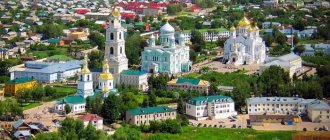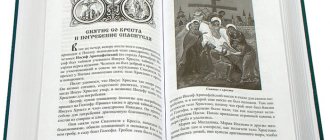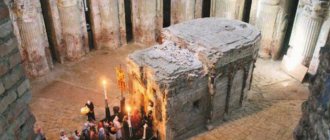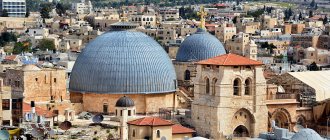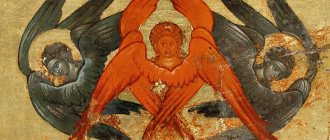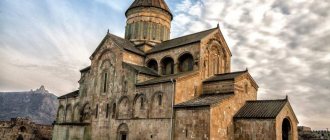What's interesting on the route
Here and further along the description there will be mainly links to materials from the site “Sarov Regional Historian”, as a source of the most reliable information on the history of Sarov and the surrounding area.
The route can be started from the village of Gorodki, which has long become just a modest holiday village. Not every one of the few gardeners and beekeepers knows that opposite the village, literally 300 meters from the Diveevo-Tsyganovka road, there is an ancient Mordovian fortification - the firmament - with a system of ramparts, located on a cape of deep ravines. Actually, this firmament – the “town” – gave the name to the village.
The village of Balykovo is now part of the closed administrative-territorial entity of the city of Sarov. Until the beginning of the 20th century, Balykovo was one of the centers of the iron ore industry of the region. The slag from this plant can still be seen in the road fill.
“From the history of the Balykovsky iron mining plant, one can see that long before the appearance of outstanding scientists of the 20th century in Sarov who created a nuclear shield here, this place was already closely connected with the names of the most talented and even brilliant names of entrepreneurs, industrialists, engineers and inventors who contributed outstanding contribution to the development of the productive forces of pre-revolutionary Russia from the last quarter of the 19th century. This expands the depth of the feeling of Sarov as one of the points on the map of our Motherland, where the forces of spirituality, high-tech production and science have merged.” (from the article by S.P. Egorshin “To the 100th anniversary of the closure of the Balykovsky iron mining plant”)
We can talk endlessly about Sarov, around which our route passes. The main city-forming enterprise of Sarov is the Russian Federal Nuclear Center, established here under the name KB-11 in 1946. Brief historically reliable information about the emergence of Sarov is available on the website “Sarov Regional Historian”, and about the period from 1946 on the website of the Federal State Unitary Enterprise “RFNC-VNIIEF”.
Within walking distance from the overnight stay is the road along which Tsar Nicholas II, hurrying with his family to the celebrations on the occasion of the canonization of Seraphim of Sarov, arrived in Sarov in 1903 (“Tsar’s Road”). Before entering Balykovo, the road ran along a birch alley, which has been preserved to this day, and before entering Balykovo a wooden front arch was built. Nowadays this road is not used, but it has also been preserved (see also A.M. Podurets “The Royal Road Today”).
At the Revealed Spring, with which the church associates its traditions, it is good to stop to rest and replenish your supply of clean water. Unfortunately, now it is not just a spring, but a “fenced church territory” with all the ensuing not always pleasant restrictions, and sometimes with a large number of pilgrims coming from Diveevo.
Crossing the Sarov-Kremenki highway, we head towards the dense protected forests of the south of the Nizhny Novgorod region. It is necessary to make a reservation that they are truly reserved, i.e. The forests on the left bank of the Satis and Arga rivers, which are part of the lands of the Mordovian State Reserve (MGZ) named after P.G. Smidovich, are closed to the public. An alternative route option involves passing through the MGZ, but only in agreement with the administration of the reserve! There are also impassable spruce forests here, but there are also many light, sunny pine forests that thrive on the sandy soils common here.
“Seraphim Stones” are boulders left here by the Dnieper glacier. Such boulders were not uncommon in these places, including the stones on which Seraphim of Sarov performed his famous feat of “pillarism.” In the article by M.A. Vlasova “On the Seraphim places of the north-eastern Sarov region”, there are many quotes about these stones from various sources, and almost none of this corresponds to the historical truth! However, these boulders are at least interesting as natural objects. There are two groups of such objects on the route - Bear-Stone, 5 km from the village of Pribrezhny, and a group of Seraphim stones near the Tsarsky monastery.
The remains of the Vvedensky (Tsarsky) skete of the Seraphim-Ponetaevsky Monastery, including the well-preserved Virgin Mary Alley, are undoubtedly a significant attraction. At one time, the monastery was created by personal order and care of Alexander II. Royalty lived here as monks. In terms of architecture and interior decoration, the monastery was truly royal, which is confirmed by photographs from the beginning of the 20th century (available in the article by M.A. Vlasova, mentioned earlier).
The “golden pillar” backup is located at the end of our route, 50 meters south of the railway crossing in the village of Steklyanny. The pillar itself marked the junction of three provinces - Nizhny Novgorod, Tambov, Penza. The original pillar has not survived, but was restored in 2005. In addition to the backup, there is also a “golden pillar” located in a historically verified location, approximately 1.5 km from the backup. The “golden pillar” itself is not included in our route, but only in its continuation to the south, or the southeastern segment of the “Sarov Around the World”, a description of which will soon also be available to travelers.
The stele near the source of the Alatyr River denotes both the source of this rather large river, the left tributary of the Sura, and the watershed of the Sura and Oka river basin. Rivers flowing from the watershed to the east, incl. Olkhovka and Sarovka are already part of the Oka River basin. The stella is located 200 meters from the “golden pillar” backup, to the right along the asphalt road, if you follow it to the east.
Along the route, near the rivers, you will probably be able to observe, if not the beavers themselves, then traces of their activity - gnawing or dams.
The following plants are of interest:
- sorrel, in May-June (in gastronomic terms)
- oregano and fireweed at the end of June - July (for tea)
- lumbago or sleep-grass in early May (very beautiful!)
You can also find mushrooms along the route. At the beginning of May there are many lines, from the end of June - other mushrooms common to the middle zone, incl. white boletus, boletus, boletus, boletus.
The route will be interesting:
- for tourists, including parents with children, as an option for a trip to the May holidays;
- for lovers of trail running (trail runners), for training and competitions;
- for cyclists: experienced - as a good workout, not too experienced - as an option for a one- or two-day hike;
- for all tourists as a route rich in natural and historical attractions.
The described route has many variations, including an interesting route through the reserve and the former Arga cordon of the Sarov Monastery. Please note that this option, in terms of walking through the reserve, requires obtaining permits from the reserve. The beginning and end of the route are located in the closed city of Sarov, and are not accessible to residents of the city of Sarov!
A fragment of a real stone of Seraphim of Sarov
EVERYTHING PRESENT arouses increased interest, especially when it comes to things and objects that are directly related to the Venerable Seraphim of Sarov himself. His original belongings are kept in the Diveyevo Monastery, and they cannot be photographed. Therefore, here we can only show illustrations - scans from literature on the Diveyevo Monastery.
Clothes and shoes of St. Seraphim of Sarov
Hoe, stool and cast iron of St. Seraphim of Sarov
Of particular interest to us is the true stone, or rather, its fragment, on which the Monk Seraphim prayed for 1000 nights.
A fragment of the stone on which St. Seraphim prayed for 1000 nights
The book illustration distorts the real color of the fragment, but we can conclude that it is most likely a coarse-grained gray granite, very similar in structure and color to our megaboulders: the Sarov boulder, the Vergar boulder and the Alatyr-stone of the Sarov region.
All the more interesting for us was the message from Anatoly Aleksandrovich Agapov that in the exhibits of the Sarov Hermitage Museum there is a fragment of a real stone of St. Seraphim of Sarov! At our request, he outlined the history of this fragment in writing, which we present below. At one of the meetings of the OIO “SP”, Anatoly Aleksandrovich presented this fragment for photographing.
A sheet with the history of a fragment of the holy stone with the autograph of A. A. Agapov
We took photographs of the fragment of Mother Seraphim’s stone from different sides:
Stone fragment of Mother Seraphim
The fragment is a sample of coarse-grained gray granite of irregular shape measuring 3 x 3 x 3 cm with colorless (apparently quartz), black and pink inclusions. It is clear from the images that the color of the granite sample in the photo greatly depends on the lighting and shooting angle. However, we can conclude that the fragment of Mother Seraphim’s stone is very similar to the sample of the stone of Seraphim of Sarov in the Diveyevo Monastery and, accordingly, may actually represent a fragment of the stone on which the Monk Seraphim prayed for 1000 nights.
However, one cannot help but be alarmed and surprised by the fact that most of the surface of the sample presented to us for photographing granite is covered with a hard, finely dispersed layer of yellow color (apparently) dolomite flour mixed with clay. This never happens on glacial boulders that lie relatively freely on the surface of the earth in Sarov and the Sarov region. But it is precisely these stones that are encountered today when digging a deep pit for the restoration of the Assumption Cathedral in Sarov, which goes into the dolomite layer. It is possible that when the FIRST REAL STONE, on which Seraphim of Sarov actually prayed for 1000 nights, was split and carried away by pilgrims as the miraculous one, the demand for these fragments became very great. So great that a whole “industry” has been established for the production of such “real-looking” fragments of the holy stone of Seraphim for all believers...
This is only a hypothesis that does not in any way detract from the civil feat of the nun of the Diveyevo Monastery Seraphim, who preserved for posterity the highest relic - a fragment of the stone on which the Monk Seraphim prayed for 1000 nights.
Nun of the Seraphim-Diveevo Monastery Mother Seraphima (photo from the “Illustrated Chronology of the Sarov Desert”)
It is important to know
Limitations and Features
For the walking route, we recommend the first ten days of May (in early spring, also the last ten days of April) and August-September. We do not recommend hiking the route in the second half of May, June and July due to the large number of blood-sucking insects. At the same time, we have positive experience in organizing a one-day cycling route in June-July.
Persons with foreign citizenship, incl. Ukrainians, Kazakhs, etc. The route is not recommended due to legal restrictions on staying in the route area. Photo and video filming of the closed city of Sarov and the security perimeter is strictly prohibited. Explain to all group members that “joking” with the sentries can end very badly. In general, it’s better to quickly walk past the perimeter (this is one very short section of the route).
The terrain on the route has minimal elevation changes, the forest cover varies, but the route mainly passes through forests, among which there are many clean and dry pine forests.
There are no technically difficult obstacles on the route.
The likelihood of encountering large wild animals is small, the danger of such encounters is minimal. As elsewhere in the middle zone, the most common snakes are the snake and the viper; it is advisable not to encounter the latter (be careful, especially in the spring); in general, there are few snakes.
Especially in the spring, the danger is posed by ticks, of which there can be quite a lot on certain sections of the route (but as of 2021, it was in the area of our marked route that not a single meeting of a marker with ticks was recorded, although there were many of them on neighboring routes). We recommend vaccinations against tick-borne encephalitis, as well as regular self- and mutual examinations during the route, at least every 3-4 hours. At the same time, your “medic” should know how to properly remove an attached tick.
In the period from the second half of May (after the grass has grown), the hogweed plant, already known to most residents of Russia, can pose a danger. The burning juice of this plant causes severe burns - this plant must not be touched under any circumstances!
Since logging is underway in the area, new forks and powerful roads may appear at any time, which should not interfere with your movement along the route.
As a rule, making fires everywhere along the route from the moment the snow melts is prohibited. Indeed, in pine forests and in conditions of last year’s dry grass, the fire danger is very high already at the beginning of May. We recommend cooking on gas burners.
About the cycling option of the route
Cyclists should take note that, unlike a simple pedestrian route, this route is of moderate difficulty for cyclists.
In spring the trails are still wet. The “thicket” section is more difficult to overcome with a bicycle than without it. And the section from the entrance to the forest to the village of Pribrezhny is mostly sandy; it’s not possible to ride a horse everywhere...
However, there is good news:
— on a bicycle the route can be covered in one day, even including entrances and exits from Sarov, it has been tested many times;
- you can make different variations, for example, exclude the Bear-Stone from the route, and from Kremenki to Pribrezhny take the “highway” through Koshelikha (in quotes, because it is very broken in places) - the distance is longer, but the time is faster.
How to get there
To Gorodki village
From Moscow it is more convenient to get to Arzamas, then by taxi or minibus (for a large group). For one or two people, it will be cheaper to get to the Metro shopping center, where from about 10:00 to 22:00 passing buses from Nizhny Novgorod to Sarov (88313092222) and Passenger (88313094444) stop. Pre-register for a flight by phone to Sarov. Explain to the driver that he needs to stop at the stop near Gorodki (after the Motor village, 2 km before the village of Khvoshchevo - the comment will be relevant, since not all drivers may be aware of what Gorodki are). Travel time from Arzamas is about 1 hour, the distance is about 65 km.
You also need to get from Nizhny Novgorod by “Fellow Traveler” or “Passenger” buses, as described above. Travel time is 3-4 hours (highly dependent on traffic jams leaving Nizhny Novgorod), the distance is about 170 km.
From Sarov it is easier and cheaper to get by regular bus 19 or minibus 21 to the final stop in Balykovo. From there, further along the same road, walk 5 minutes to checkpoint-2 (open only in the spring-summer-autumn season from 7 to 22 hours without breaks). After checkpoint 2, follow the road in a westerly direction to the Gorodki stop, about 10 minutes.
By bicycle you can get from Sarov along the track “FROM_GORODKOV_ON_BIKE”.
To Steklyanny village
From Moscow by train Moscow-Bereshchino, take a ticket to the final station. From Bereshchino on the same train, which then goes as a commuter train to Sarov, for an additional fee you can get to Steklyanny. Warn the conductors, because you will have to disembark in “5 seconds”. It's night on the road from Moscow.
After disembarking, walk further along the road to the crossing. The “Golden Pillar” - the beginning of the route - is located 50 meters south of the crossing, the route itself goes north.
By bicycle you can get from Sarov along the track “TO_GLASS_ON_BIKE”.
From Gorodki
For Sarov residents - through checkpoint-2, as described above.
To Arzamas or Nizhny Novgorod - on the “Fellow Traveler” or “Passenger” buses, but at the same time explain the boarding location to the dispatcher in detail, and also remind yourself 10-15 minutes before the bus arrives by calling the dispatcher again. It would be even more reliable to take a taxi to Diveevo (about 10 km), and then leave from there on a “Hellow Traveler” or “Passenger”, while you can also see Diveevo - this should preferably take at least 4 hours.
From Steklyanny village
About boarding the train at Steklyanny, ask local residents or the forester (the house is near the crossing, at the very end of the route). Continue as upon arrival (see above).
You can also get by regular bus from Sarov to Pervomaisk (“Pervomaisk Gorkovsky”), the journey is less than half an hour, the distance is about 20 km, from there by train to Moscow or Arzamas (one train, departure in the evening). It is better to check the bus schedule in advance at the bus station in Sarov.
It is more convenient to get to Nizhny Novgorod through Pervomaisk, from where there are regular and private buses to Nizhny Novgorod; the schedule needs to be clarified.
There are also options for starting (ending) the route at the Yavlenny spring, in the village of Pribrezhny and (for Sarov residents) at checkpoint-4 (after its opening).
You can only get to (from) the spring Revealed by your own transport or by taxi from Diveevo. The option of regular buses is unlikely to be successful.
You can get to the village of Pribrezhny by your own transport or by taxi from Diveevo (which will be expensive, since it is relatively far away, and the road is broken, as everyone knows).
The opening of checkpoint-4 is expected, after which Sarov residents will also be able to quickly get to the Yavlenny spring or the intersection of the Sarov-Kremenki highway, for example, by taxi. It is also planned to additionally mark exits to the route directly from checkpoint-4.
Places for rest and overnight stays
Option for overnight stay at the beginning of the route (near Gorodki, if necessary):
— the left bank of the Vichkinza/Shakleika river (N 54 58.935' E 43 18.701'), near the beginning of the route - a lot of firewood, water from the river, needs to be boiled.
OR
— the floodplain of the Shakleika River, at the beginning of the preserved section of the royal road (N 54 59.400' E 43 20.044') - a lot of firewood, go to the Kremenka River for water, 5 minutes (in spring - to the nearby stream).
If you don’t need firewood, and there are a lot of mosquitoes, then it’s better to stand somewhere on a hillock. For example, not far from the Yavlenny spring, but not quite near the village, for example, here N 54 59.564' E 43 20.995'
Overnight on the route (in the area of the Tsarsky Skete):
- stream after turning to Bear-stone (N 54 56.562' E 43 29.063') - there is firewood, water from the stream, OR the right bank of the Satis River N 54 56.643' E 43 29.475' - there is firewood, water from the Satis River.
OR
- the right bank of the Satis River directly behind the Tsar's monastery (N 54 57.077' E 43 23.033') - there is firewood, water from the river, minus parking - relative proximity to the residential buildings of the monastery, plus - proximity to the observation tower and the Virgin Mary alley.
Option for overnight stay at the end of the route (at Steklyany, if necessary):
If necessary, you can spend the night directly in front of the village (N 54 54.783' E 43 35.458'). The place here is quite quiet, it is unlikely that anyone will disturb you. There is enough firewood here, but you will have to go to the local residents in the village for water.
As a rule, making fires everywhere along the route from the moment the snow melts is prohibited. Indeed, in pine forests and in conditions of last year’s dry grass, the fire danger is very high already at the beginning of May. We recommend cooking on gas burners.
Water
Clean drinking water, suitable for consumption without treatment, is only available along the route at the Revealed Spring. Residents of the city of Sarov can also get water from a pump at the final stop in Balykovo (as a rule, this pump is always working).
Water from the rivers Vichkinsa, Satis, and streams requires boiling.
In Steklyany you can ask local residents for drinking water.
The shops
There is no store in Gorodki. In the village of Steklyanny there is only a car shop, you can’t count on it.
During the season, there may be merchants at the Manifest Spring from whom you can buy pies, etc. There is a store in the village of Kremenki, but it is located in the center of the village, i.e. A little out of the way, you'll have to stop by specially. Because The village is large, then you can count on a store.
In the village of Pribrezhny, the old name, which is still in use, is Timber Plant (it is a little off the route), there is also a store. The work schedule as of the beginning of 2021 is Mon-Fri 9-16, Sat 10-15, Sun closed.
Don't forget to take it with you
- Supplies of food and drink.
- Suitable clothing and shoes.
- Personal and group equipment.
- Repellents against mosquitoes, ticks and other insects in the summer.
- First aid kit.
- A printed map, route description, as well as track and points loaded into your navigator or phone.
